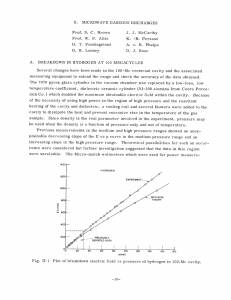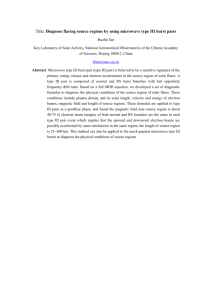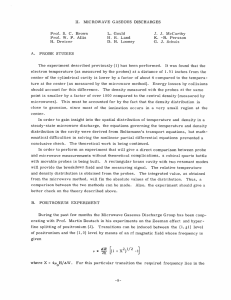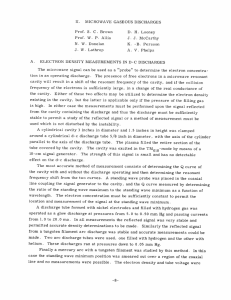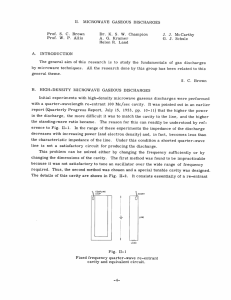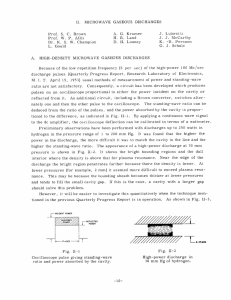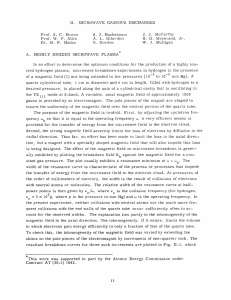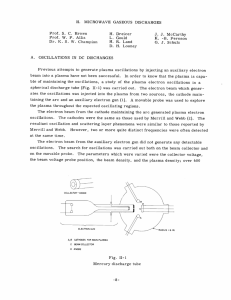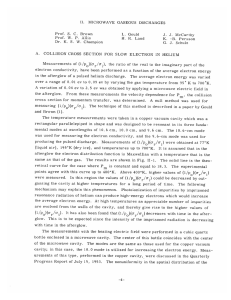II. MICROWAVE GASEOUS DISCHARGES E. Gordon
advertisement
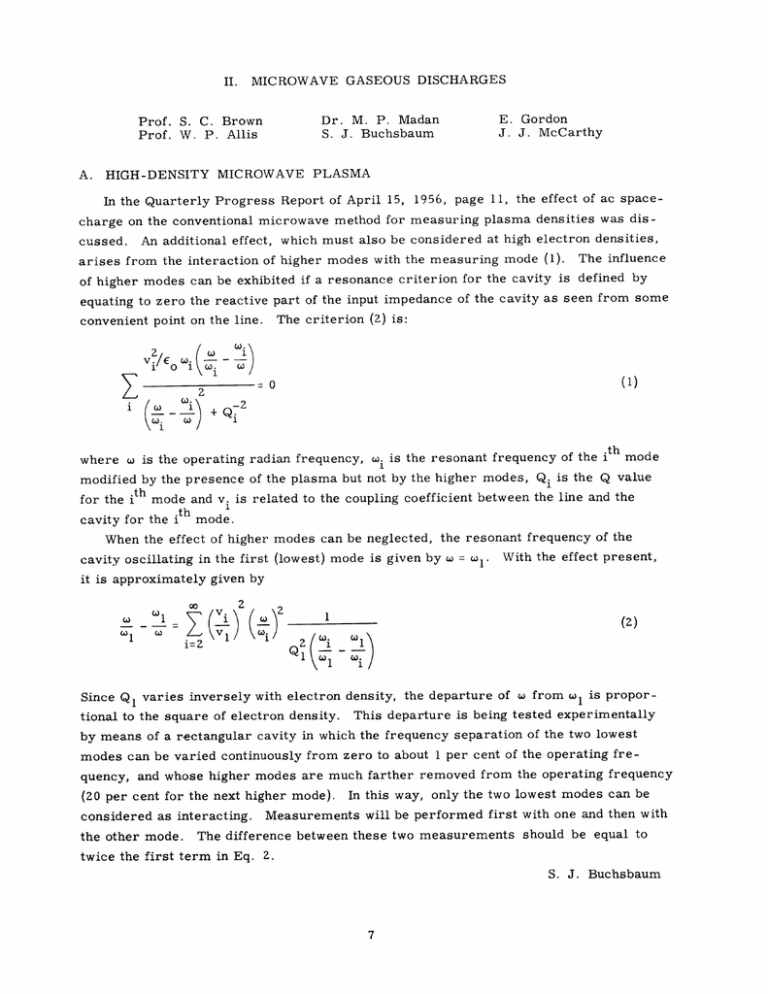
MICROWAVE GASEOUS DISCHARGES II. A. E. Gordon J. J. McCarthy Dr. M. P. Madan S. J. Buchsbaum Prof. S. C. Brown Prof. W. P. Allis HIGH-DENSITY MICROWAVE PLASMA In the Quarterly Progress Report of April 15, 1956, page 11, the effect of ac space- charge on the conventional microwave method for measuring plasma densities was discussed. An additional effect, which must also be considered at high electron densities, arises from the interaction of higher modes with the measuring mode (1). The influence of higher modes can be exhibited if a resonance criterion for the cavity is defined by equating to zero the reactive part of the input impedance of the cavity as seen from some The criterion (2) is: convenient point on the line. 10o+ (W (1) +Q)-2 Wi) where w is the operating radian frequency, wi is the resonant frequency of the ith mode modified by the presence of the plasma but not by the higher modes, Qi is the Q value for the ith mode and v. is related to the coupling coefficient between the line and the th 1 mode. cavity for the i When the effect of higher modes can be neglected, the resonant frequency of the cavity oscillating in the first (lowest) mode is given by w = l. With the effect present, it is approximately given by o 2 11 1 i=z2 2 1 (2) l) Since Q 1 varies inversely with electron density, the departure of W from tional to the square of electron density. 1 is propor- This departure is being tested experimentally by means of a rectangular cavity in which the frequency separation of the two lowest modes can be varied continuously from zero to about 1 per cent of the operating frequency, and whose higher modes are much farther removed from the operating frequency (20 per cent for the next higher mode). considered as interacting. the other mode. In this way, only the two lowest modes can be Measurements will be performed first with one and then with The difference between these two measurements should be equal to twice the first term in Eq. 2. S. J. Buchsbaum (II. MICROWAVE GASEOUS DISCHARGES) References 1. K. Persson, Private communication. 2. J. C. Slater, Microwave Electronics (D. Van Nostrand Company, Inc., 1950), Chap. IV. B. PULSE BREAKDOWN IN GASES New York, The continuity equation, used to study the build-up of the discharge in a resonant cavity, is an i - n (1) where v.n is the production of electrons per second by ionization and D n/A 2 is the number of electrons diffusing per second. A single pulse breakdown is quite random, field (1). depending on the initial density and the All of the observed breakdown times are greater than a minimum time that corresponds to one initial electron. Starting with one electron the electron density builds up, slowly at first when free diffusion is the controlling factor, and then more rapidly as a positive ion space-charge that inhibits the diffusion of electrons is built up. As the density builds up appreciably, the resonant frequency shifts, the value of Q drops, the power begins to be reflected back. and The density nb at which we begin to see these reflections can be computed from the curves given in the Quarterly Progress Report of April 15, 1956, page 12. Making use of the calculations given by Allis and Rose (2), we computed the times for various ranges of density up to nb by numerical integration, first, using D effective diffusion coefficient, and then leaving it out. s, the Comparison of the two times indicated an average difference of less than 3 per cent, which is well within the range of experimental error. We concluded that as far as time measurements are concerned, free diffusion can be considered the controlling factor, up to nb. If Eq. 1 is integrated and rewritten in suitable form, it becomes -i 1 tp nb In -1 - Dp (2) the proper variables being Ee/p, vi/p, Dp, tp, and pA. measured experimentally for different values of pA. Time as a function of E can be The variation in pA is either by varying p or by varying A with different cavities. of time for a 0. 25-inch cavity were made. effected Preliminary measurements At the present time, measurements are being made on 0. 125-inch and 0. 625-inch cavities that were constructed for the purpose of (II. MICROWAVE GASEOUS DISCHARGES) obtaining different values of A as well as ensuring the existence of a uniform field. The new measurements are expected to yield values of Dp and vi/p directly, as is clear from the form of Eq. 2. M. P. Madan, J. J. McCarthy References 1. Quarterly Progress Report, p. 18. 2. W. P. Allis, D. J. Rose, Research Laboratory of Electronics, Phys. Rev. 93, 84 (1954). Jan. 15, 1956,


